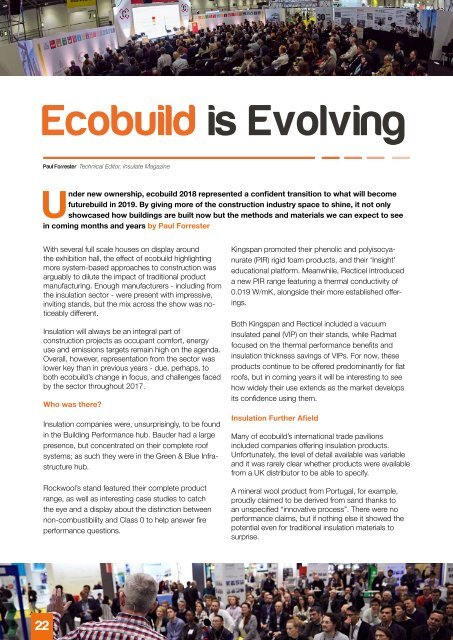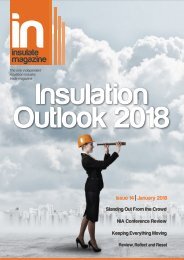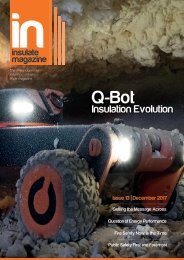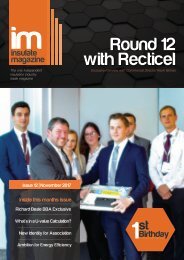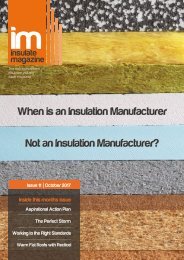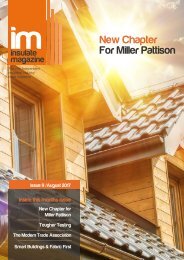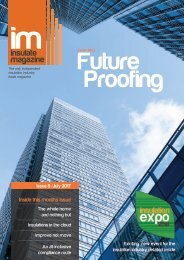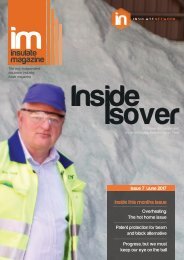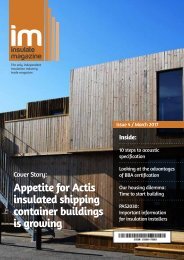Insulate Magazine Issue 17
You also want an ePaper? Increase the reach of your titles
YUMPU automatically turns print PDFs into web optimized ePapers that Google loves.
22<br />
22<br />
Ecobuild is Evolving<br />
Paul Forrester Technical Editor, <strong>Insulate</strong> <strong>Magazine</strong><br />
Under new ownership, ecobuild 2018 represented a confident transition to what will become<br />
futurebuild in 2019. By giving more of the construction industry space to shine, it not only<br />
showcased how buildings are built now but the methods and materials we can expect to see<br />
in coming months and years by Paul Forrester<br />
With several full scale houses on display around<br />
the exhibition hall, the effect of ecobuild highlighting<br />
more system-based approaches to construction was<br />
arguably to dilute the impact of traditional product<br />
manufacturing. Enough manufacturers - including from<br />
the insulation sector - were present with impressive,<br />
inviting stands, but the mix across the show was noticeably<br />
different.<br />
Insulation will always be an integral part of<br />
construction projects as occupant comfort, energy<br />
use and emissions targets remain high on the agenda.<br />
Overall, however, representation from the sector was<br />
lower key than in previous years - due, perhaps, to<br />
both ecobuild’s change in focus, and challenges faced<br />
by the sector throughout 20<strong>17</strong>.<br />
Who was there?<br />
Insulation companies were, unsurprisingly, to be found<br />
in the Building Performance hub. Bauder had a large<br />
presence, but concentrated on their complete roof<br />
systems; as such they were in the Green & Blue Infrastructure<br />
hub.<br />
Rockwool’s stand featured their complete product<br />
range, as well as interesting case studies to catch<br />
the eye and a display about the distinction between<br />
non-combustibility and Class 0 to help answer fire<br />
performance questions.<br />
Kingspan promoted their phenolic and polyisocyanurate<br />
(PIR) rigid foam products, and their ‘Insight’<br />
educational platform. Meanwhile, Recticel introduced<br />
a new PIR range featuring a thermal conductivity of<br />
0.019 W/mK, alongside their more established offerings.<br />
Both Kingspan and Recticel included a vacuum<br />
insulated panel (VIP) on their stands, while Radmat<br />
focused on the thermal performance benefits and<br />
insulation thickness savings of VIPs. For now, these<br />
products continue to be offered predominantly for flat<br />
roofs, but in coming years it will be interesting to see<br />
how widely their use extends as the market develops<br />
its confidence using them.<br />
Insulation Further Afield<br />
Many of ecobuild’s international trade pavilions<br />
included companies offering insulation products.<br />
Unfortunately, the level of detail available was variable<br />
and it was rarely clear whether products were available<br />
from a UK distributor to be able to specify.<br />
A mineral wool product from Portugal, for example,<br />
proudly claimed to be derived from sand thanks to<br />
an unspecified “innovative process”. There were no<br />
performance claims, but if nothing else it showed the<br />
potential even for traditional insulation materials to<br />
surprise.


